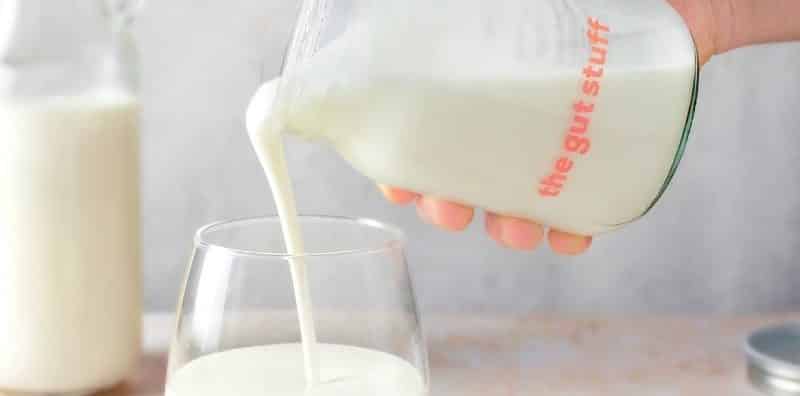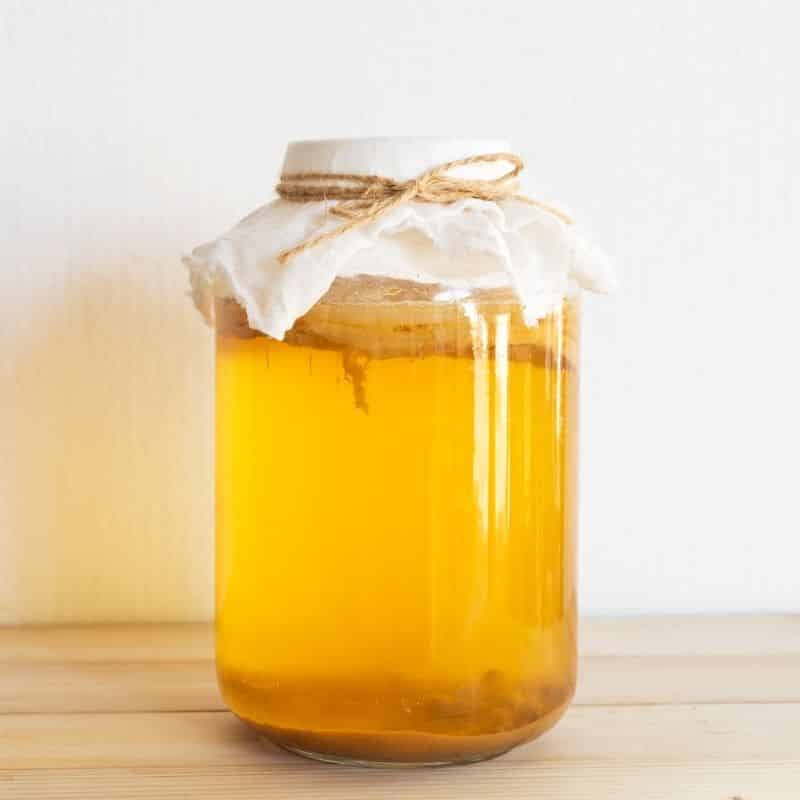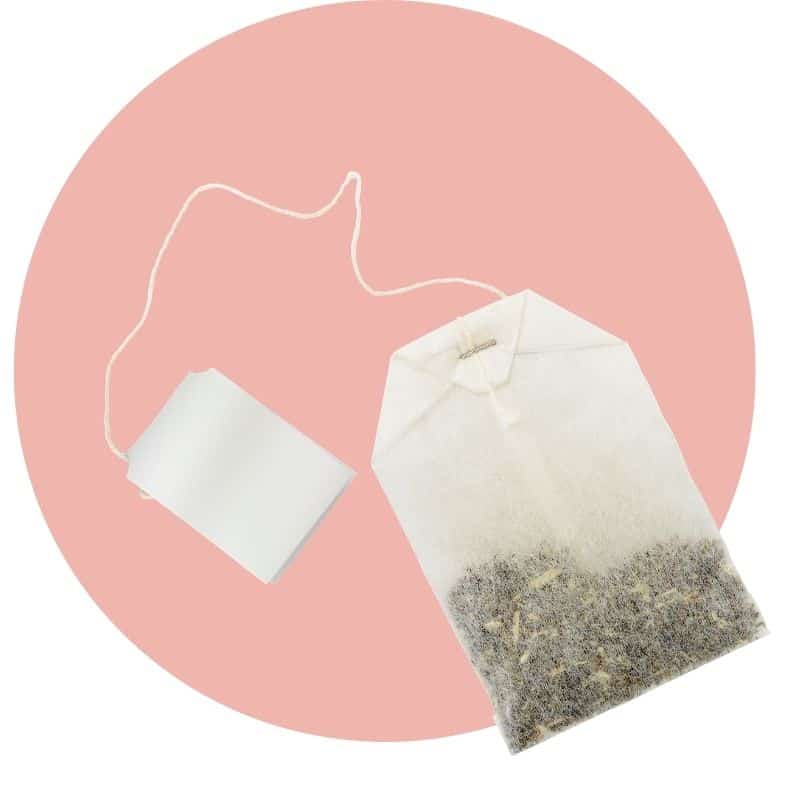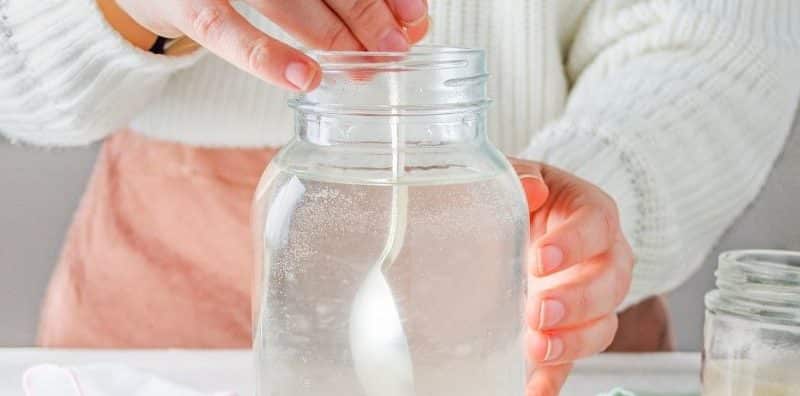
how to make kombucha

meet the ferment*…
history: Kombucha is believed to have begun with small brewed batches thousands of years ago in Northeast China. Kombucha was bought into the mainstream in about 1995 when America’s first kombucha was founded. It’s known as ‘booch’ to its fans and is now home-brewed globally.
what is it? A type of fermented tea with a tangy flavour and a bit of fizz.
flavour: Fizzy, a little tart/sour
Kombucha is a fermented drink made from sweetened tea. In its most simple form, it’s a blend of tea, sugar, water and a SCOBY (which looks a bit like a jellyfish!). Most of the sugar is consumed by the yeast and bacteria, keeping the sugar content of kombucha relatively low. Kombucha naturally contains acetic acid and polyphenols.
ingredients
1700ml water (filtered)
4 black tea bags
120g cane sugar
200g finished kombucha (or the liquid the SCOBY is packaged in)
1 SCOBY
equipment
(included in our All in One Fermentation Kit)
1L jar
gauze
other equipment
rubber band
thermometer
funnel

method
- Wash your jar in hot soapy water, then place it in the oven at 100°C for 15-20 mins to sterilise it, then leave to cool.
- In a saucepan bring the water and sugar to the boil. Once up to temperature and all the sugar has dissolved remove the pan from the heat and add the tea bags. Steep for 5-10 mins. Remove the tea bags and allow to cool to room temperature.
- Add the mixture to your 2L jar, add in the finished kombucha and your SCOBY and cover the jar with the gauze, fixing it in place with a rubber band. Leave the jar out on a countertop at room temperature but out of direct sunlight.
- Fermentation can take anywhere from 5-14 days depending on your desired taste. Begin tasting the kombucha after 5 days. As the kombucha ferments, its sugary sweetness will diminish as its acidity rises. Once it has reached your desired level of tanginess remove the SCOBY and reserve 200ml of kombucha to brew your next batch.
- Strain the finished kombucha through a sieve to remove any stray particles that may have formed during fermentation. Bottle your brewed kombucha into a clip top bottle using a funnel then either store in the fridge or leave it out for another 48 hours to add carbonation.
- Repeat the process using the SCOBY and reserved kombucha to make a fresh batch of kombucha.
storage
Store in the fridge for up to a month unopened, once opened best consumed within 7 days.
“gaahhh” confused? need help?
SCOBY is an acronym for Symbiotic Culture Of Bacteria and Yeast. More specifically, it is the community of microorganisms that live in both the kombucha’s liquid and the thick, floating mat or “mother” as it’s colloquially called.
You can use less sugar, but you cannot make kombucha without any sugar. Without the sugar there is no fermentation. The sugar in the kombucha recipe is what the SCOBY feeds off of. As it ferments, that sugar is primarily transformed into a small amount of alcohol, acetic acid and carbon dioxide while the microbes multiply. If you’re worried about sugar consumption, the sugar in the kombucha recipe can be dropped down to about 5% by weight, but note that the finished product will be much weaker in its final flavour.
Kombucha’s taste will change over time. The longer it ferments, the less sweet and more like vinegar it will become. Left too long it can become overwhelmingly sour. It’s important to catch it at just the right moment in time!
What most people visually recognise as the SCOBY isn’t actually the yeast or bacteria (even though they live within it) but a mat of cellulose – the same stuff that makes up the fibre in plants. SCOBYs will start off as thin translucent films and if the microbes in your kombucha are healthy and thriving the SCOBY will thicken as it ferments (most often into a smooth surfaced, opaque sheet, that is tan to white in appearance). Its buoyancy means it usually floats, but it may move around, sink, bubble up, or even tilt on its side as the mixture ferments and that’s totally fine.
The older a SCOBY gets, the wispier and browner it may become. However, even if the SCOBY never grows large or thick, it doesn’t mean your kombucha has failed! Some liquids are just better at providing the raw building blocks the microbes need to construct a thick mat, but in its absence, it doesn’t mean they aren’t fermenting.
Yes it does. The yeasts within the SCOBY produce alcohol that is then consumed by the bacteria it lives alongside when they turn it into acid. The process normally comes with a little lag time, meaning that there’s always a small amount of alcohol in your kombucha, most often in the range of 1-2%, or roughly what you’d find in overripe fruits.
If left too long, your SCOBY can overferment your base, leading to it tasting more like vinegar than a refreshing tonic. The easiest way to fix this is to brew the same amount of the sweetened tea mixture that you did at the start of the recipe, but with half the sugar, and pour it in until the acidity is tempered to a palatable level.
All manners of teas and tisanes can be used to brew kombucha successfully. Feel free to substitute the same quantity of tea bags for your favourite blend. You can even use strained fruit juices (like apple juice or cranberry juice) though you won’t need to add any sugar to those recipes to turn them into kombucha.
If you’d like to grow your kombucha’s SCOBY you can store it in a “SCOBY hotel”. Simply dissolve 100g of sugar into 1L of water and add in the reserved 200ml of old kombucha along with your SCOBY. Cover the container with the gauze and a rubber band and leave it on your counter out of direct sunlight. Your SCOBY will consume the sugar and grow considerably in size, letting you take cuttings of it to share with friends or family who also want to get into brewing kombucha.
If you are looking to farm your microbes however, your SCOBY can easily be stored in the 200 ml of reserved kombucha in a sealed container in the fridge for several weeks without any adverse effects.
Bottling your kombucha a couple days in advance of your estimation of when it will be finished will trap in any carbon dioxide produced by the yeast. From there, leaving the clip top bottle in the fridge for a little while longer will help to develop even more bubbles, so long as you aren’t opening the bottle often.
If you’re looking for champagne like effervescence, try adding a couple tablespoons of sugar (roughly 30g, or 3%) per litre into the mixture, before you bottle it. This will start a secondary fermentation that carbonates the mixture as the yeasts within the SCOBY ferment in the absence of oxygen. Be aware that this technique can lead to higher alcohol levels in your kombucha than if you were to consume it normally.
A kombucha that you strain, bottle, and place in the fridge still contains all the microbes responsible for fermentation in the first place. In the absence of the original SCOBY, the microbes in the kombucha will start growing a replacement raft, even in a bottle in the fridge. It doesn’t mean your kombucha is spoiled, simply alive! Just use a small sieve when pouring yourself a glass to enjoy.
*Fermented foods may not be suitable for everyone, for example, if you are immunocompromised. Speak to your medical professional if you have any concerns.
